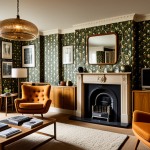Sourcing Authentic Vintage Pieces in the UK
When sourcing vintage furniture UK and antiques, it is essential to focus on authenticity to ensure you acquire true vintage or antique pieces. The antique shops UK landscape offers a rich variety of options, from well-established physical stores to thriving online marketplaces specializing in British vintage home decor shopping. Notable shops in cities like London, York, and Bath provide expertly curated collections with provenance, while markets such as the Portobello Road Market in London remain treasure troves for genuine finds.
Identifying authentic vintage and antique items requires attention to several factors. Look for signs of age, including natural wear patterns consistent with decades of use, such as slight fading, minor scratches, or original hand-crafted joinery. True vintage furniture UK pieces often show craftsmanship details such as dovetail joints and hand-planed surfaces, distinguishing them from modern reproductions. Pay attention to sellers who can share the items’ history, as provenance adds credibility and value.
In parallel : How Can Technology Transform Our Living Spaces at Home?
When sourcing antiques UK, it’s helpful to research typical materials and construction methods relevant to the period and region. For instance, Victorian-era pieces may display elaborate carvings and solid hardwood construction specific to that time. Avoid items with suspiciously uniform finishes or machine-made markings, which often indicate modern replicas. Vintage home decor shopping in the UK also involves understanding terminology tied to eras—knowing the difference between ‘vintage’ (generally 20 to 100 years old) and ‘antique’ (100+ years old) helps set expectations.
By combining visits to reputable antique shops UK with explorations of vintage fairs and vetted online retailers, collectors and decorators can confidently source authentic pieces. This multifaceted approach ensures access to quality vintage furniture UK and complements the rich tradition of British vintage home decor shopping.
Also read : How to choose the right lighting for a UK home?
Iconic Vintage Styles Suited for UK Interiors
Understanding British vintage decor styles is key to selecting pieces that harmonize with UK homes. Among the most celebrated is mid-century modern UK, characterized by clean lines, organic forms, and functional elegance. This style emerged post-World War II, spanning the late 1940s to the 1960s, reflecting optimism and innovation. Key features include tapered wooden legs on furniture, minimal ornamentation, and muted color tones, making it highly adaptable for contemporary living spaces.
Another hallmark is art deco interiors, popular in the UK between the 1920s and 1940s. Art deco is distinguished by bold geometric patterns, rich colors, and luxurious materials such as lacquer, chrome, and glass. Furniture in this style often features symmetrical shapes and exotic motifs, emphasizing glamour and sophistication. When sourcing vintage furniture UK of this era, look for streamlined silhouettes combined with intricate detailing.
Victorian style completes the trio of British vintage classics. Originating in the 19th century, Victorian furniture is known for its ornate craftsmanship, heavy proportions, and use of dark woods like mahogany and walnut. This style often features carved accents, tapestry upholstery, and polished finishes, enriching traditional British interiors with historical depth.
Choosing the right vintage style depends on your home’s architecture and your design preference. For an airy, light-filled space, mid-century modern UK offers simplicity and warmth. If you seek drama and opulence, art deco interiors bring that bold flair. Victorian pieces complement heritage properties, adding a layer of authentic British charm.
By recognizing these distinct styles—mid-century modern UK, art deco interiors, and Victorian furniture—you can confidently blend vintage elements with contemporary British homes, ensuring a graceful and timeless aesthetic.
Mixing Vintage and Modern Elements in British Homes
Blending vintage furniture UK with contemporary pieces creates an eclectic interiors UK style that brings warmth and personality to any space. A successful approach to mixing old and new involves striking a balance where vintage items become focal points rather than overwhelming the room. For example, pairing a striking mid-century modern UK sideboard with sleek modern seating can anchor the room while maintaining a fresh feel.
When integrating modern vintage home decor, consider scale and color harmony. Vintage pieces with bold shapes or ornate details work well as statement items against simpler, minimalist backgrounds. Conversely, subtle Victorian accessories or vintage fabrics add texture and depth when placed alongside clean-lined modern furnishings.
Lighting can play a crucial role, too. Combining vintage lamps or chandeliers with contemporary lighting fixtures enhances contrast and highlights unique design features from both eras. This strategy enriches the layered look that defines eclectic interiors UK without losing cohesion.
To create an intentional and harmonious look, choose a unifying theme such as color palette or material. For example, selecting vintage furniture UK with natural wood tones and complementing these with modern accents in brass or matte black can tie the overall decor together seamlessly. Similarly, mixing vintage textiles with modern upholstery fabrics ensures tactile interest without visual clash.
Ultimately, mixing old and new in British homes allows for curated personal expression. Embracing both eras with thoughtful planning results in interiors where vintage furniture UK and contemporary pieces coexist, enhancing style and comfort.
Colour Palettes and Textiles for Vintage UK Interiors
Selecting the right vintage colour palettes UK is foundational when designing authentic British vintage interiors. Traditional schemes often include muted tones like sage green, mustard yellow, dusty rose, and deep navy, reflecting historical preferences seen in British stately homes and terraces. These colours create a warm, inviting atmosphere that perfectly complements vintage fabrics UK known for their rich textures and intricate patterns.
Retro textiles play a vital role in sustaining period authenticity. Look for materials such as chintz, velvet, and brocade, which were commonly used in upholstery and curtains throughout the 19th and 20th centuries. Floral motifs, tartans, and geometric patterns are signature prints that enrich the vintage aesthetic and resonate well within British vintage decor styles. By integrating these textiles, rooms gain tactile interest and visual depth without overpowering the space.
A practical approach to mixing textiles involves layering different fabric types and patterns while maintaining a coherent colour story. For example, pairing a velvet chintz throw pillow with a wool tartan blanket on a neutral-toned sofa can evoke both comfort and elegance. Choosing vintage colour palettes UK that harmonise with the wood tones and finishes of period furniture further enhances the atmosphere.
Incorporating authentic vintage fabrics into elements like curtains or upholstered chairs not only preserves style but also improves durability, as these materials were crafted to withstand daily use. For enthusiasts engaging in vintage home decor shopping, sourcing such textiles offers tangible links to past eras, making interiors feel genuinely timeless and characterful.
Restoring and Upcycling Vintage Finds
Restoring and upcycling vintage furniture UK breathe new life into cherished pieces while preserving their character. When undertaking vintage restoration, start by assessing the item’s condition. Look for structural stability, original joinery, and surface damage. Prioritize repairs that maintain authenticity, such as using wood glue and clamps on loose joints rather than replacing parts completely. Avoid sanding away patina, as this natural wear adds value and aesthetic appeal in vintage furniture UK.
For practical DIY vintage home projects, choose finishes and materials compatible with British timber types common in antique furniture, such as oak or mahogany. Use environmentally friendly stains and paints to enhance wood grain without masking it. When addressing upholstery, opt for traditional fabrics that match the piece’s era, preserving authenticity and comfort.
Upcycling furniture UK also offers creative ways to renew items, mixing the old with the new. For example, repainting a vintage dresser in muted tones aligned with vintage colour palettes UK can transform it into a statement piece suitable for modern interiors. Adding brass or matte black hardware updates functionality and style without sacrificing heritage.
Effective vintage restoration tips include:
- Carefully cleaning surfaces with appropriate, gentle products to avoid damage.
- Repairing rather than replacing original components when feasible.
- Using period-appropriate techniques and materials to maintain historical integrity.
Engaging in vintage restoration and upcycling supports sustainable practices while enhancing the charm and storytelling potential of your British vintage decor. This hands-on approach allows collectors and decorators alike to create functional pieces that honor their provenance within contemporary settings.
UK Resources for Vintage Interior Enthusiasts
Discovering authentic vintage furniture UK and vintage homewares online UK starts with knowing where to look. The UK offers an array of vintage shops UK and antique markets UK, each bringing unique selections that cater to different tastes and budgets. Noteworthy physical venues include London’s Portobello Road Market and Birmingham’s Jewellery Quarter market, both renowned for their extensive antique offerings and vintage homewares. These markets provide an opportunity to interact directly with sellers and inspect items closely—essential for sourcing antiques UK with confidence.
Beyond bustling markets, numerous reputable vintage homewares online UK stores specialize in curated collections, delivering convenience without sacrificing authenticity. When using online platforms, scrutinize seller reviews and request provenance information to assess reliability and item genuineness. Many online vintage retailers offer detailed photography and descriptions that highlight construction and wear, helping buyers identify true vintage furniture UK remotely.
Attending British flea markets, auctions, and interior fairs also greatly enriches the vintage sourcing experience. Auctions, for example, can yield exceptional pieces, though beginners should familiarize themselves with bidding procedures to avoid overpaying. Interior fairs often combine antiques with contemporary vintage-inspired designs, broadening the scope for enthusiasts seeking eclectic interiors UK or modern vintage home decor.
Tips for navigating these UK resources include arriving early at markets to access the best finds, negotiating politely with sellers, and learning to distinguish quality craftsmanship characteristic of genuine vintage furniture UK. Engaging with veteran collectors or local experts can enhance buying skills, ensuring each new acquisition contributes meaningfully to your vintage home collection.
By tapping into these diverse channels—vintage shops UK, antique markets UK, and trusted vintage homewares online UK—enthusiasts can confidently build interiors rich in history, style, and personality.
UK Resources for Vintage Interior Enthusiasts
Exploring vintage shops UK and renowned antique markets UK is integral to successful vintage home decor shopping. Markets such as Portobello Road in London and Birmingham’s Jewellery Quarter offer extensive selections of authentic antiques and vintage homewares, providing firsthand inspection opportunities crucial for verifying item authenticity. Collectors should arrive early, enabling choice picks from vast inventories, and negotiate respectfully to secure favourable deals.
For convenience and expanded access, many turn to vintage homewares online UK. Credible platforms showcase detailed images and thorough descriptions, helping buyers assess provenance and craftsmanship remotely. When sourcing antiques UK online, carefully reviewing seller feedback is essential to avoid replicas. Requesting provenance details adds confidence, particularly when high-value pieces are involved.
Engaging with British flea markets, auctions, and interior fairs broadens exposure to diverse vintage furniture UK and collectibles. Auctions require bidders to understand procedures fully to navigate competitive pricing effectively. Interior fairs uniquely blend vintage and contemporary designs, facilitating eclectic interiors UK. These events also serve as networking hubs, where connecting with experienced collectors enhances knowledge and buying strategies.
Veteran experts recommend blending visits to physical venues with online research and community involvement. This multifaceted approach ensures access to authentic pieces while expanding expertise in identifying quality vintage furniture UK. Ultimately, leveraging these UK resources empowers enthusiasts to build collections that reflect both historical significance and personal style.






